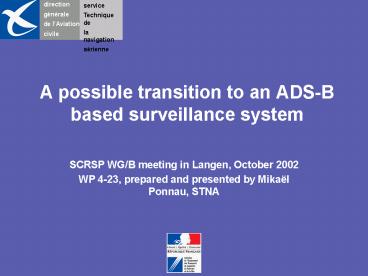A possible transition to an ADSB based surveillance system - PowerPoint PPT Presentation
1 / 11
Title:
A possible transition to an ADSB based surveillance system
Description:
A possible transition to an ADS-B based surveillance system. SCRSP WG/B meeting in Langen, October 2002 ... A communication protocol between ADS-B and Mode S sensors : ... – PowerPoint PPT presentation
Number of Views:68
Avg rating:3.0/5.0
Title: A possible transition to an ADSB based surveillance system
1
A possible transition to an ADS-B based
surveillance system
- SCRSP WG/B meeting in Langen, October 2002
- WP 4-23, prepared and presented by Mikaël Ponnau,
STNA
2
Presentation items
- Proposals for a sweet transition
- Technical means for a sweet transition
- Extended squitter processing by a Mode S sensor
- A communication protocol between ADS-B et Mode S
sensors - A phased deployment of ADS-B sensors
3
Proposals for a sweet transition (1/2)
- Current situation an independent SSR based
surveillance consisting of monopulse and Mode S
sensors - Envisaged situation an ADS-B based surveillance
system depending of the navigation system - ICAO recommendations for any new surveillance
system (Doc 9684 chapter 10 extracts) - At least the same level of performance as the
former system - A fall back system to get positional data
4
Proposals for a sweet transition (2/2)
- To meet the recommendations, it is proposed
- To enhance the existing SSR coverage with ADS-B
sensors (gap filling application) - Completing the coverage where there are detection
holes cone of silence, terrain screening, masks - The first deployed ADS-B sensors will complete
the existing SSR coverage - To deploy progressively the next ADS-B sensors
until the SSR coverage is completely redounded
with an ADS-B coverage - The ADS-B based surveillance system can then be
the primary mean for surveillance - To keep maintaining some of the SSR sensors which
will constitute the fall-back system in case the
positional data of ADS-B sensors is felt
erroneous or is missing - Both systems become complementary
5
Technical means for a sweet transition (1/4)
- Extended squitters processing by a Mode S sensor
- Type of extended squitters
- Position squitters (05 or 06) contains the same
information as a Mode S All Call reply used to
acquire Mode S aircraft - Other extended squitters contain airborne
parameter - Expected benefits to process extended squitters
in a Mode S sensor - Surveillance of aircraft on the ground (aircraft
will directly be interrogated selectively) - No need for All Call period in a 100 ADS-B
environment more time for Roll Call period to
interrogate more aircraft or to perform more data
link - Local tracking enhancement (to maintain or
enhance existing tracks) thanks to extended
squitter data - Surveillance coverage enhancement when the sensor
receives extended squitters from a remote ADS-B
sensor strategically located
6
Technical means for a sweet transition (2/4)
- Extended squitters processing by a Mode S sensor
(continue) - Technical means to acquire extended squitters
- Using the reception channel of the Mode S sensor
(though the ? diagram of the rotating antenna or
though an omni antenna installed on the same
tower) ? a feasibility study is undergoing - Using an external interface the Mode S sensor
receives surveillance data delivered by a remote
ADS-B sensor ? similar interfaces exist for
clustering operation
7
Technical means for a sweet transition (3/4)
- A communication protocol between ADS-B and Mode S
sensors - ADS-B sensors or the multi sensor tracker can
request support to the Mode S sensor for some
aircraft - Support is requested when positional data is
doubtful or is missing - The Mode S sensor maintains a list of aircraft
thanks to the surveillance data it receives from
ADS-B sensors (the sensor is client of the
surveillance server) - When support is requested it selectively
interrogates the aircraft and sends back the
measured position to the ADS-B sensor or the
multi sensor tracker (whichever made the request) - Such interfaces and protocols already exist for
the operation of a Mode S cluster
8
Technical means for a sweet transition (4/4)
Mode S sensor
ADS-B station
List of aircraft
? Diagram
9
Phased deployment of ADS-B sensors (1/3)
- Phase 1
- The primary surveillance mean is the SSR
surveillance system - ADS-B sensors complete the Mode S coverage
- The Mode S sensor process the squitters thanks to
- the added ADS-B sensors
- its own ? diagram
- The surveillance system is enhanced
10
Phased deployment of ADS-B sensors (2/3)
- Phase 2
- Progressive deployment of ADS-B sensors
- The primary surveillance mean remains the SSR
surveillance system - New sources of surveillance information for the
ATC system
11
Phased deployment of ADS-B sensors (3/3)
- Phase 3
- The primary surveillance mean is the ADS-B
surveillance system - Some Mode S sensors are maintained for the
fall-back mode - Note taking a 250 NM range for a Mode S sensor
and a 60 NM range for an ADS-B sensor, this
(very) simple drawing shows that 15 ADS-B sensors
are required to almost complete the same
surveillance coverage ! 5 more would be required
if the ? diagram was not used.































